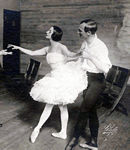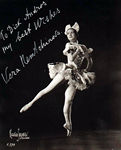Ballet Russe de Monte Carlo
Diaghilev's Ballets Russes was the premier ballet company of Europe from 1909 to 1929. When most people hear the name Ballet Russe they think of one ballet company. In fact, Diaghilev's Ballets Russes fostered the creation of many other companies. Most of these companies went by the name Ballet Russe, in one form or another.
The Russian Revolution caused Diaghilev to start picking up dancers where he could. Ruth Page, an American, joined the company in 1925. Many English and French dancers also were members in the final years such as : Alicia Marks (renamed Alicia Markova), Anton Dolin, Margaret Craske, Marie Rambert, Ninette de Valois and many others. Serge Lifar, a Russian, whom we associate with the Paris Opera Ballet, was one of the last male stars of the Ballets Russes de Sergei Diaghilev. Many of his dancers continued with other companies throughout the world.
Many of Diaghilev's dancers left to start their own companies. Diaghilev hated competition and didn't want to divide the audience. He felt that the defectors were traitors, especially when they presented ballet from his repertoire. (At this time there were no copyright laws protecting choreography. One reason for this was the lack of an efficient, universally accepted system of dance notation).

The most famous defector was Anna Pavlova who, after her performances with Diaghilev in 1909, engaged some of Ballets Russes' dancers for her own company, although she, Adolph Bolm, and Nicholas Legat had performed many times outside of Russia before dancing with Diaghilev. While still members of the Maryinsky and Bolshoi, Pavlova and Mikhail Mordkin (who many years later helped found Ballet Theatre) appeared in 1910 at New York City's Metropolitan Opera. By 1913 Pavlova had left Russia forever. She traveled the world with her company until her death in 1931.
Another deserter, Ida Rubinstein, a very wealthy and beautiful amateur, danced for Diaghilev in the title role in Fokine's Cleopatra. She also danced the leading role of Zobeide in his Scheherazade. She had no qualms about employing many of the great choreographers from Diaghilev's company, such as Bronislava Nijinska, Mikhail Fokine and Leonide Massine. Rubinstein retired in 1935 and gave all her commissioned works to the Paris Opera.
Mikhail Mordkin left Pavlova's company to form his All-Star Imperial Russian Ballet. He also used dancers from the Ballets Russes. Mordkin toured America from 1911 to 1912, and in 1926 the Mikhail Mordkin Ballet. In 1939 he was one of the founders, together with Lucia Chase and Richard Pleasant, of Ballet Theatre -- now known to us as American Ballet Theatre.
Adolph Bolm, another Diaghilev dancer organized Ballet Intime which toured America from 1918 to 1920. He was the creative force behind the Chicago Opera Ballet, and in 1933, he founded the San Francisco Opera Ballet. Ballet Theatre called upon Bolm to choreograph ballets for their earliest season.
Leonide Massine also left Diaghilev to dance with some of his many colleagues, and also danced and created choreography for the famous Roxy Theatre in New York City from 1927 to 1930.

Vera Nemtchinova and Anton Dolin started their own ballet company in 1927, together with Anatole Oboukhoff, who was Nemtchinova's husband. It is no wonder that Diaghilev felt hurt, for it was his efforts that had brought all these dancers to the West.
The Ballets Russes remained the major ballet company in the Western World until Diaghilev's death in 1929. Because these other companies existed there were places for many of the dancers to find work after the demise of the Ballets Russes. Many of the dancers chose not to return to Russia because the Revolution left many of them without a home.
Two men who joined forces to continue the Diaghilev tradition were René Blum, director of the Monte Carlo Opera Ballet, and Colonel Vassili de Basil, associated with L'Opera Russe à Paris. They hired George Balanchine and Leonide Massine as choreographers and Serge Grigoriev as regisseur-general. Grigoriev had a remarkable ability for remembering every detail of Diaghilev's repertoire. Balanchine introduced the three "Baby Ballerinas" Tamara Toumanova, Irina Baronova and Tatiana Riabouchinska. Advertising these three prodigies gained much needed publicity to launch the company.
The repertoire consisted of works from Diaghilev's company and new works by Balanchine and Massine. Balanchine was fired in the first year, because the audiences preferred Diaghilev's repertoire and Massine's ballets. Balanchine went on to form his own company Les Ballet 1933. Unfortunately it was not a financial success -- luckily for America, because Lincoln Kirstein invited Balanchine to start a school in the Metropolitan area.
René Blum and Col. de Basil Ballets Russes de Monte Carlo company was about to declare bankruptcy when an American impresario, Sol Hurok, took over the management in 1934 and booked the company in the USA at the St. James Theatre. Hurok lost a considerable amount of money, but the second season saw a larger audience. Hurok thought it was time ballet took its rightful place in American culture. He booked the company into the Metropolitan Opera House at 39th Street and the season was a great success. The name was changed to the singular Ballet Russe de Monte Carlo.
Because of difficulties between Blum and de Basil, Blum gave up his share of the partnership, leaving Massine and de Basil to run the company. According to many reports, it was impossible to work with de Basil. Massine left after his contract was fulfilled and returned to Monte Carlo, where he formed another company with Blum. Many of de Basil's dancers followed Massine and joined René Blum's Ballet Russe de Monte Carlo.
The new company got backing from Julius Fleischmann, of the Cincinnati Yeast Fleischmanns, who became President. New York financier Serge Denham served as vice president.
When Massine discovered his ballets belonged to de Basil, he brought a law suit in London that captured the imagination of the press. They reported the events of the trial daily. Finally, the courts decided de Basil did own the ballets. Both companies could use the name Ballet Russe, but de Basil had to drop "de Monte Carlo."
Hurok also severed his connection with de Basil's company and became manager for Massine and Blum. Hurok was sure the American public could not support two companies, so he tried to get the companies back together. Meanwhile, de Basil's company called themselves Covent Garden Ballet Russe, Educational, Ballet Ltd and finally Original Ballet Russe. In 1938 the two companies were performing in London at the same time. De Basil was at Covent Garden and Blum was two blocks away at the Drury Lane. Ballet lovers could run back and forth, from one theater to the other, and see the ballets of their choice.
Through an all-night session, the management of the two companies got together and ironed out their differences. But at the last moment de Basil said no to the offer.
Once Hurok was managing both companies at the same time, and he booked the Ballet Russe to play four weeks at the Hollywood Theatre (now called the Mark Hellinger), immediately followed by the Original Ballet Russe. It was the longest ballet season to hit New York -- a solid fifteen weeks.
Eventually Serge Denham took over the Ballet Russe de Monte Carlo as director and artistic advisor. When World War II started, the companies made New York City their permanent home. The quiet, reserved René Blum remained in Europe and was imprisoned at the Auschwitz concentration camp and murdered by the Nazis in 1942.
For years, dancers would perform in one company one season and in another company the next. Many went to Ballet Theatre, which made a successful debut in 1940. Balanchine's American Ballet was having a difficult time getting a foot-hold, but still was competition for the other companies. Denham held his position until he was killed by a bus on Fifth Avenue in 1970.
Marquis George de Cuevas, an American patron of the arts, married the granddaughter of John D. Rockefeller and became a very important figure in the dance world. Although born in Chile, he acquired the title "Marquis" from his Spanish father. That and the Rockefellers' money made him a power to be dealt with. He became interested in Ballet while helping to organize the 1939 World's Fair. He then founded Ballet Institute and Ballet International in 1943. They made their debut in New York City using many American-trained dancers. Texas-born Nana Gollner became the first American to be promoted to prima ballerina of a European company. In 1947 de Cuevas created the Grand Ballet de Monte Carlo. The common thread uniting all these companies was Sol Hurok.
During World War I (1914 - 1918) Diaghilev's company was in Europe, and then the Russian Revolution took place, (1917 - 1918). Edward Caton said that in spite of the World War and two Revolutions (Kerensky and Bolshevik), ballet studies continued uninterrupted. The lean days at close of W.W.I and the economic pinch frustrated many creative artists, C. F. Ramuz and Igor Stravinsky collaborated on a project that included musicians, actors and dancers. This project, called "L'Histoire du Soldat", only used seven musicians and four actors and dancers. It was also a breaking away for Stravinsky from the Russian orchestral school.
After each war there is a recovery period and prosperity, and the company flourished. The year of Diaghilev's death was the beginning of the great Depression. The Depression was worldwide. Regardless, companies sprung up all over the western world- - "you might as well be a starving dancer as a starving investment broker." Many of the companies took the name Ballet Russe: Ballet Russe de Monte Carlo, The Original Ballet Russe, Rene Blum's Ballet Russe. The companies then, as today, were always on the verge of bankruptcy. The national companies managed to keep intact, such as the Paris Opera Ballet, although I am sure they also had their problems.
By 1931 Hitler's rise to power caused unrest the world over. Sono Osato's book "Distant Dancers" gives her account of the period up through Wold War II. Arnold Haskel recounts in his book "Ballet Since 1939" of the effect the W.W.II had on the English Ballet. When America entered W.W.II in 1941, most of the men were called to serve in the armed forces. The companies that managed to get to the USA did so with dancers that were citizens of the world. Some, like Igor Youskevitch, enlisted in the service. I remember every program listing its members that were in the armed services. I was fifteen years old when I saw my first ballet - - "The Ballet Russe", starring Frederic Franklin and Alexandra Danilova. At that moment I knew I wanted to dance.
Also at this time, a new dance form was developing. Today we call it modern dance. "Originally a reaction against the rigidity of ballet. More body movement - more depth - no shoes. It has become a form of its own, with its own classical vocabulary", according to Nancy Stevens. The pioneers were Isadora Duncan, Mary Wigman, Kurt Jooss, Ruth St. Denis and her husband Ted Shawn who had a dancer in their company named Martha Graham. You might add the name of Michael Fokine. I will talk more on modern dance later.
Western ballet for the most part stays away from politics. A few brave souls have taken on the world, such as Kurt Jooss's "The Green Table" and Anthony Tudor's "Echoing of Trumpets". Both ballets have an anti-war message.
(First published February 1997)